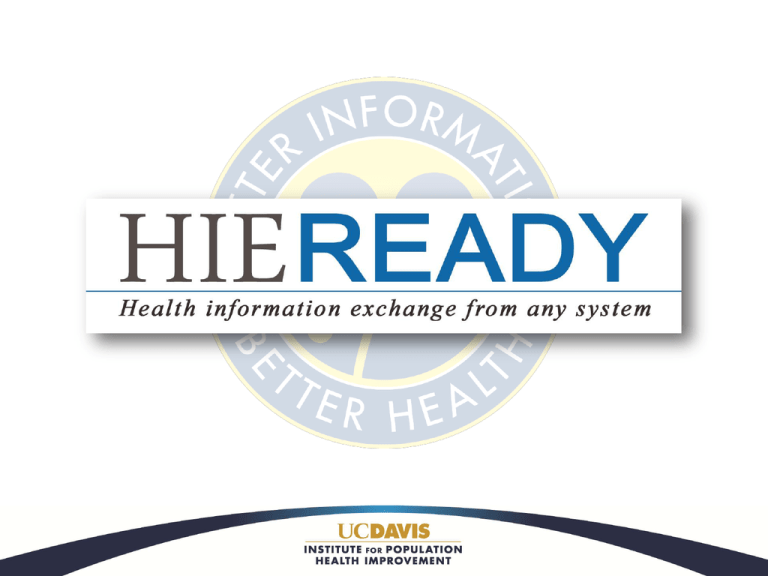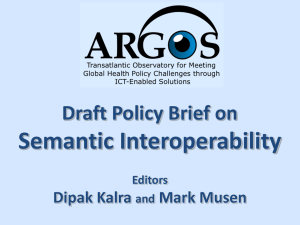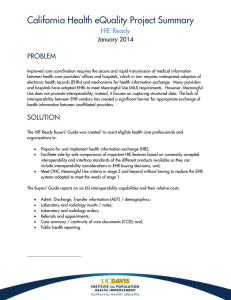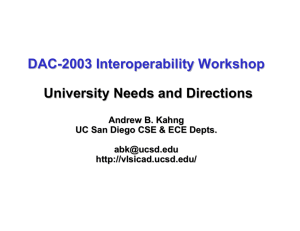Document 13193010
advertisement

What is the problem? Physicians are not IT professionals. – Focused on seeing patients and meeting meaningful use requirements. Meaningful Use does not promote interoperability. – Focused on capturing structured data. EHR vendors find interfaces a distraction. – Interoperability does not sell EHRs to EPs. What is the result? No “single standard” for data. – Every interface is different. Interface data variability is high. – Every interface requires analysis. – Ever installation has its own interoperability specifications. Causes labor-intensive analysis and design that slows down access to interoperability. – Backlog for EHR interfaces can be months long. – Custom interfaces increase cost of “simple” interoperability. – Creates a data divide – large organizations get interoperability first, smaller organizations have to wait. Ultimately, providers don’t know how to buy interoperability, and EHR vendors don’t know how to sell it. What is the result? The unintended consequence of Stage 1 Meaningful Use is EHRs are creating data silos. Data goes in, but it doesn’t go out. How about Stage 2? Stage 2 adds critical requirements for interoperability. Stage 2 further constrains some standards. Stage 2 comes too late for many providers. – Many will already have spent their EHR incentives and cannot afford the time or cost of an upgrade. But it’s not happening in 2011! How do we address the problem? Create “HIE Ready” A common set of interface and interoperability capabilities agreed upon by vendors and stakeholders and deliverable today. What was our approach? Start with what is available today. Clarify options in existing standards. Allow HIE to take responsibility for content mapping, not the EHR vendor. Let the market drive things forward. What is HIE Ready? Set of capabilities that define interoperability. – Starts with Stage 1 MU. – Adds specificity where there are options or ambiguities. – Paves the way for Stage 2. Statement that capabilities are supported. – Built upon common standards. – Must be available in a shipping product. Commitment to offer interoperability… … as a single, orderable “part number” … with a quoted price. Agreement that interoperability is everyone’s responsibility… … but that creating interfaces is HIE’s job. What is HIE Ready NOT? Not a set of requirements. – Not asking vendors to support every capability, just be transparent in what they support. Not a requirement to support emerging standards. – California is committed to emerging standards. – HIE Ready is not an alternative, but compliments these efforts. EHR HIE Interoperability WOR KGR OU P Not even preferred pricing. – Interoperability need not be free, but you must disclose how much it costs. What does it do? Creates transparency. – You know what a product supports, today. – You know what interoperability will cost. Makes it easier to buy interoperability. – Providers need not educate themselves on every standard. – Creates language that might be used for a contract with a vendor. Reduces costs. – Reduces the need for analysis and custom interfaces. Creates uniformity. – Everyone supports the same thing. Allows EHR vendors to concentrate on functionality. What does it include? “Set of capabilities that define interoperability…” – A matrix of 57 capabilities that cover: ADT messages and patient demographics. Lab results, radiology reports, and encounter notes. Lab and radiology orders. Referrals and appointments. Care summary exchange using CCDs. Reporting of immunizations and lab results for reportable conditions. – Versions (so far) for ambulatory EHR vendors, in-patient EHR vendors, and HIOs. Pricing for everything supported. What does it look like? What does it look like? Questions? See our web site at: http://www.ucdmc.ucdavis.edu/iphi/Programs/cheq/HIEReady.html Send us email at: cheq@ucdmc.ucdavis.edu



